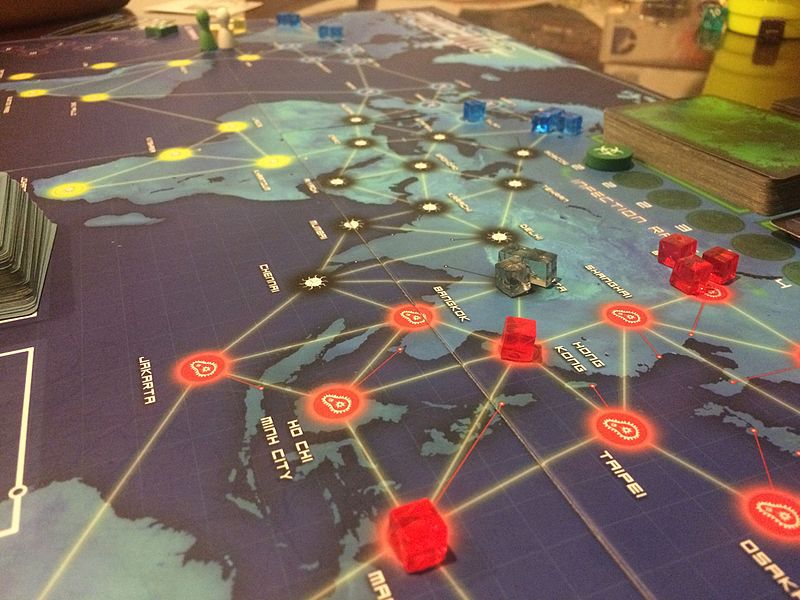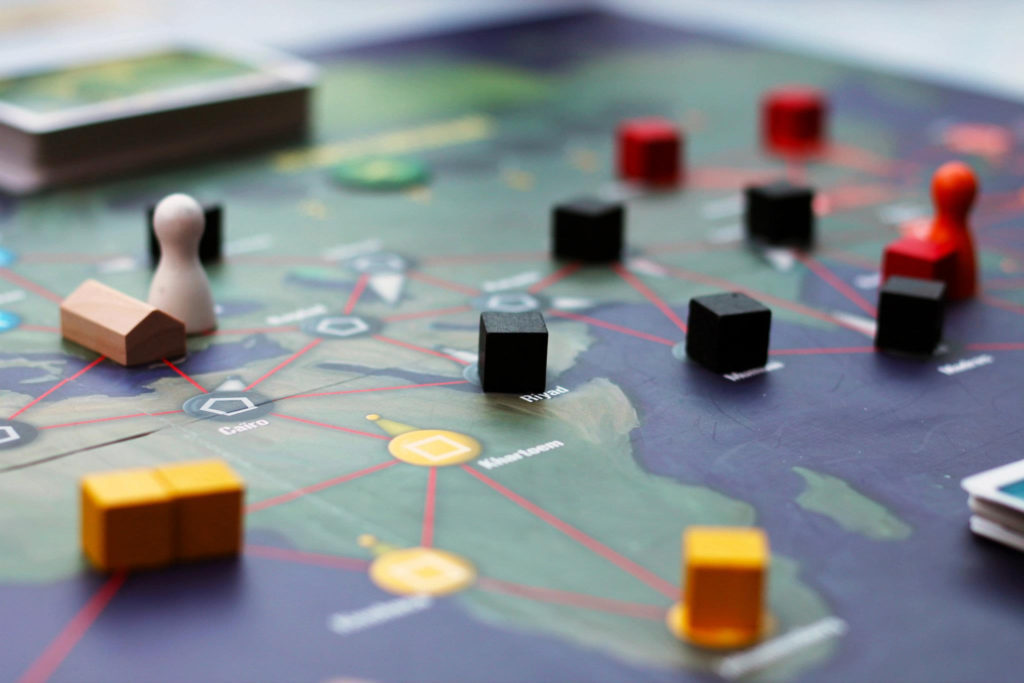Roll up your sleeves and go to the nearest CVS for your flu shot. Today’s breakdown is for Pandemic, one of my favorite board games of all time. In fact, this is the one for me – the one that opened my eyes to the larger board game community. It is the one that broke me out of the prison of Monopoly, Yahtzee, and other games that many hardcore board gamers love to hate with an irrational vigor.

Looking for more resources to help you on your board game design journey?
Here you go: no email required!
Like this writing style?
Check out my latest blog on marketing here.
Pandemic blows the minds of a lot of new gamers because it’s often the game that introduces the concept of cooperative board game play. That alone is enough to make it special, but it’s no one-trick pony. You play as members of the CDC fighting four pandemics, each of which are constantly threatening to wipe whole metropolitan areas off the map. The game excellently conveys this tension with a steady drip-drip-drip of new infections (often in already ill areas), sporadic and disastrous “epidemics”, and extremely well-connected cities. Meanwhile, you have only a handful of players working 24/7 to contain the disease, prevent outbreaks, find a cure, and work within the limitations of your time and resources.
Pandemic is a cooperative game for 2-4 players. All players work together to beat the game. You win together or you lose together. There are four diseases, each represented by a different color cube – red, yellow, blue, and black. The objective is to cure all the diseases by collecting five cards that correspond to each color and discarding the cards at a CDC research station.
Here’s the three main obstacles to success:
- These diseases slowly add up in different regions. When more than 3 cubes of one color end up on one city, there’s an outbreak, and you have to put a disease cube on each connected city (infecting up to SIX others). If you hit 8 outbreaks, you lose. Outbreaks can cause chain outbreaks, too, so if you get one, you’re likely to get two or three or four at the same time.
- If you run out of cards to draw, you lose. This is basically a time limit.
- If you run out of disease cubes, you lose because your disease is too far spread (or the makers of the game were cheap, we’ll never know which).
Pandemic is easier to play than describe, so I won’t get into much more detail. What I’ve said so far is enough background to understand the points I’m going to make. Here are three reasons Pandemic is excellent at getting people to work together.
The goal is simple.
Cure the disease! Somebody collects five cards of the same color and discards them at a research station. Then the disease is cured. Do this for each color and you win.
The simplicity of this objective really pins the game down, since the logistics can get hairy. Some decisions you may face include: passing color cards between players, efficiently moving around within the limits of the four-action-per-turn rule, and containing the disease so you can keep it under control long enough to develop a cure.
Experienced players can do the heavy lifting while neophytes can intuitively understand why the table leaders are doing what they’re doing.
You have to contain the disease to minimize outbreaks, a game of tactics.
Pandemic is a team sport. No player can carry the game – it’s impossible. If you try to collect cards and develop cures while completely ignoring the festering pockets of disease in Jakarta or Johannesberg or Osaka, you’re going to get your respective butts handed to you. Some players may opt to keep diseases under control. Some may set up a network of research stations (for easier transportation and pursuit of the overall objectives). Others may focus heavily on finding the cures. There’s a lot of factors to balance, and communicating with your team for long enough to coordinate actions is critical.
You have to plan around contingencies because of the element of chance.

Epidemic cards are effectively random. They can pop up at any time and put three disease cubes on a city. This can cause already infected cities to explode into outbreaks and completely clean cities to become hotbeds primed for disaster. When an epidemic card comes up, you and your team have to work together to respond very quickly, even at the expense of your previous tactical objectives and your overall objective of curing the diseases.
There’s a lot of ground I haven’t covered. There are subtle nuances of movement in Pandemic. Extra tactical and strategic elements are provided by different roles. Diseases, because of some niche rules around epidemic cards, tend to – quite sensibly – get worse in cities that are already infected. It’s a well thought-out game that captures the tension and coordination of crisis control.
Now excuse me while I complete this application for medical school.





8 thoughts on “Pandemic: Getting People to Work Together”